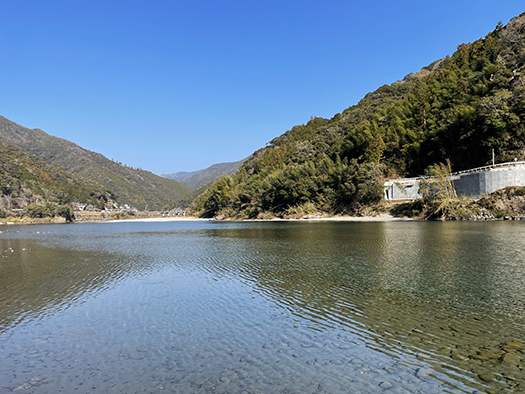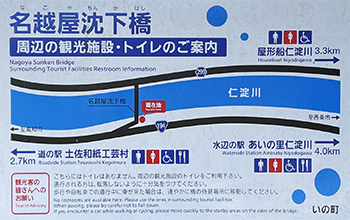


北海道人であるわたしが本州以南地域を旅するのにはいろいろな心理的動機があるのでしょう。東京関東圏には首都機能・人口密集地としての活力をみるし、関西圏の歴史を背景とした時間の重層性など、さまざまな「ニッポン」との出会い感がある。
そういうなかでちょっと不思議な心理に至るのが四国との出会い。就職が決まって最初に会社のみなさんと共同行動を経験した「原体験」的なことはあるけれど、その後、ほぼ数十年経過して家族旅・夫婦旅を重ねてみると、温暖地域の中でもっとも「自然豊か」ということに癒されていることがわかる。
中央構造線が四国を東西に走ることでそれに沿って山岳地域が形成される。北側の瀬戸内海地域の方が人口集積が大きい。しかし全体として人口規模がそれほどでもないことから山地には巨大な森が保存され続け、そこで蓄えられた豊かな水量が流れるとき「清流」を生み出している。その名前の印象深さから四万十川が有名だけれど、清流を教えてと高知で街の方に聞いたら「仁淀川」と即座に答えられた。
さらにその清流には「沈下橋」という聞き慣れない橋が架けられているという。「なにそれ」であります(笑)。字の通りに考えると水の下に消えてしまう橋。そんなの橋の用を足さないではないか、という素朴な疑問。ということで探索に向かった次第。それが写真のような状況であります。
沈下橋は低水路・低水敷と呼ばれる普段水が流れているところだけに架橋され、また床板も河川敷・高水敷の土地と同じ程度の高さとなっていて、低水位の状態では橋として使えるものの増水時には水面下に沈んでしまう橋のこと。河川行政的には「潜水橋」という。写真のこちらは名越屋沈下橋という橋。
背景としての清流は奇跡の清流と呼ばれる仁淀川。国土交通省による水質調査結果で何度も「水質日本一」に選定。透明度が高いため水面と川底が青く輝く「仁淀ブルー」の愛称でも親しまれている。


わたしはさすがにチャレンジしませんでしたが、この橋をクルマで通行する人もいた。歩道と車道の区別も特段なく、速度はひとの歩く速度に自然と合わせられているように感じる。そういうのがまた、いかにも独特の雰囲気を醸し出してくれる。あとで調べたら、北海道内でもいくつかこの沈下橋はあるのだそうです。
どうもひたすら高速道路に合わせた時間感覚の中でわたしたちは日常生活を送っている。そういうことにこれら清流や沈下橋は、「まぁちょっと待てや」と言ってくれているように感じられた。
English version⬇
Niyodo River, a clear stream in Shikoku, and a “submerged bridge.
A submerged bridge that hides in the water flow when the water level rises. Symbiosis with the abundant water volume rivers of the Shikoku mountainous region. I feel that human society has a mindset of obedience to nature. …
As a Hokkaido-native, there are probably a variety of psychological motivations for me to travel to areas south of Honshu. In the Tokyo-Kanto area, I see the vitality of the capital city and its dense population, and in the Kansai area, I feel a sense of encounter with various aspects of “Japan,” such as the multilayered nature of time against the backdrop of its history.
In this context, the encounter with Shikoku is a little strange. Although I had the “original experience” of working together with everyone at my company when I first started my career, after about half a century has passed and I have traveled with my family and as a couple, I find that I am most comforted by the “richness of nature” in the warmer regions.
The Median Tectonic Line runs east to west across Shikoku, forming a mountainous region along it. The Seto Inland Sea region to the north has a larger population concentration. However, because the overall population size is not so large, huge forests continue to be preserved in the mountainous areas, and the abundant amount of water stored there produces “clear streams” when they flow. The Shimanto River is famous for its impressive name, but when I asked a person in Kochi to tell me which clear stream he was referring to, he immediately replied, “The Niyodo River.
He also told me that there is an unfamiliar bridge called a “sunken bridge” across the clear stream. What is that? If you think of it literally, it is a bridge that disappears under the water. (Laughs.) A simple question: “Wouldn’t such a bridge serve no purpose? That is why we set out to search for it. The situation is as shown in the photo.
A submerged bridge is a bridge that is constructed only where water normally flows, called a low waterway or low water bed, and the floor plate is the same height as the land of the riverbed or high water bed, so that it can be used as a bridge when the water level is low but sinks below the water surface when the water level rises. In river administration terms, it is called a “submerged bridge. This one in the photo is called the Nagoshiya Submerged Bridge.
The clear stream in the background is the Niyodo River, which is called a miraculous clear stream. It has been repeatedly selected as the “best water quality river in Japan” according to the results of water quality surveys conducted by the Ministry of Land, Infrastructure, Transport and Tourism. The river is also known by the nickname “Niyodo Blue” because of its high transparency, which makes the surface and bottom of the river glow blue.
I did not challenge the bridge, but there were some people who drove their cars over the bridge. There is no particular distinction between sidewalks and roadways, and the speed of traffic seems to naturally match the speed of people walking. This also creates a unique atmosphere. I found out later that there are several sunken bridges like this in Hokkaido.
I think that we are living our daily lives with a sense of time that is constantly adapted to the expressway. I felt as if these clear streams and sunken bridges were telling us to “wait a minute.
Posted on 3月 23rd, 2023 by 三木 奎吾
Filed under: 日本社会・文化研究







コメントを投稿
「※誹謗中傷や、悪意のある書き込み、営利目的などのコメントを防ぐために、投稿された全てのコメントは一時的に保留されますのでご了承ください。」
You must be logged in to post a comment.